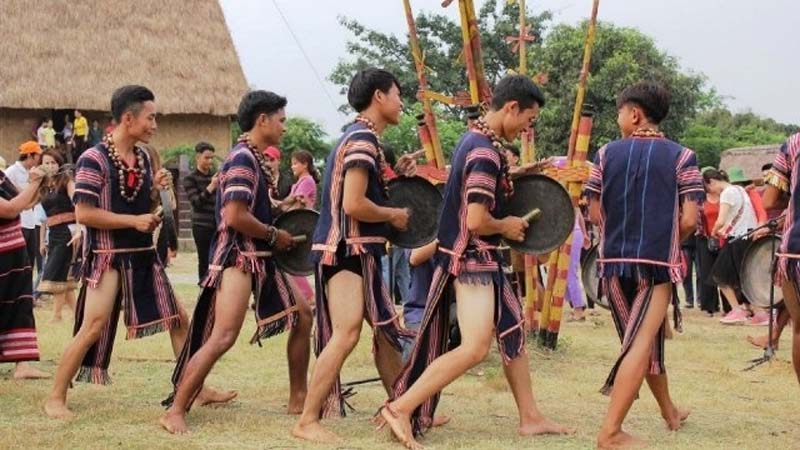
The Vietnam National Village for Ethnic Culture and Tourism, in the Dong Mo tourism area of Son Tay town in Hanoi, is hosting a programme celebrating the cultural diversity and customs of the Central Highlands region this June.

Gong performances are an indispensable part of the programme
The programme has attracted around 90 ethnic people from 12 groups in
the region, including Ta Oi, Co Tu, Raglai, E De, and Khmer, among others.
The programme introduces visitors to folk songs and
lullabies of the Central Highlanders, as well as the making of their
traditional musical instruments and cloth weaving.
A cooking contest, gong performances, sporting events and
folk games are also indispensable parts of the month-long event.
Notably, children visiting the village can register for a
free training course on experiencing the Buddhist monastic life. During the
two-day courses, on June 2-3 and June 16-17, participants will learn about
Buddhist rituals and Buddha’s teachings on humanism and being a well behaved
child.
During June, a number of traditional festivals of ethnic
groups will be held in the village, such as a new house warming ceremony by the
Cham group from Ninh Thuan, and the ceremony of brotherhood and longevity
celebration by the Ede
people in Dak Lak province.
Source: NDO
With an increasingly vibrant and widespread emulation movement aimed at building cultured residential areas and cultured families, Yen Thuy District has been making steady progress toward improving both the material and spiritual well-being of its people, while fostering a civilized, prosperous, beautiful, and progressive community.
Once lacking recreational spaces and community facilities, Residential Group 2 in Quynh Lam Ward (Hoa Binh City) has recently received attention for the construction of a new, spacious, and fully equipped cultural house. The project followed the model of state support combined with public contributions in both labor and funding.
The "All people unite to build cultural life" movement, which has been effectively integrated with Kim Boi district’s socio-economic development goals, is fostering a lively spirit of emulation across local residential areas, hamlets, villages, public agencies, and enterprises. In addition, through the initiative, traditional cultural values are being preserved and promoted, while community solidarity and mutual support in poverty reduction and economic development are being strengthened.
A working delegation of the Hoa Binh provincial People’s Committee led by its Permanent Vice Chairman Nguyen Van Toan on June 11 inspected the progress of a project to build the Mo Muong Cultural Heritage Conservation Space linked to tourism services in Hop Phong commune, Cao Phong district.
Born and growing in the heroic land of Muong Dong, Dinh Thi Kieu Dung, a resident in Bo town of Kim Boi district, in her childhood was nurtured by the sweet lullabies of her grandmother and mother. These melodies deeply imprinted on her soul, becoming an inseparable part of her love for her ethnic group's culture. For over 20 years, this love for her hometown has driven Dung to research, collect, and pass down the cultural values of the Muong people to future generations.
In the final days of May, the Ethnic Art Troupe of Hoa Binh Province organized performances to serve the people in remote, mountainous, and particularly disadvantaged areas within the province. These were not just ordinary artistic shows, but they were the meaningful journeys aimed at spreading cultural values, enhancing the spiritual life of the people and contributing to the preservation of ethnic minority cultural identities.


